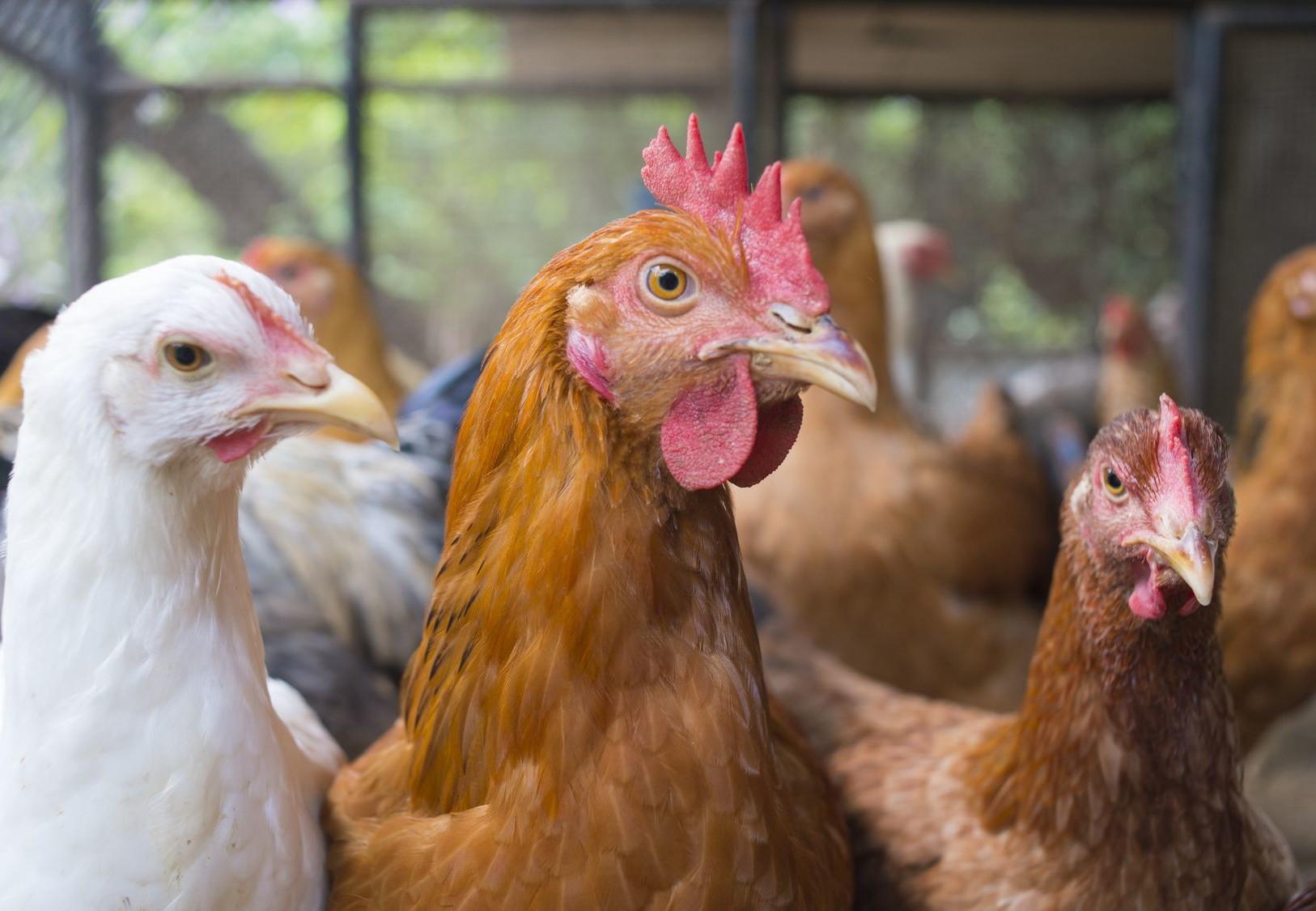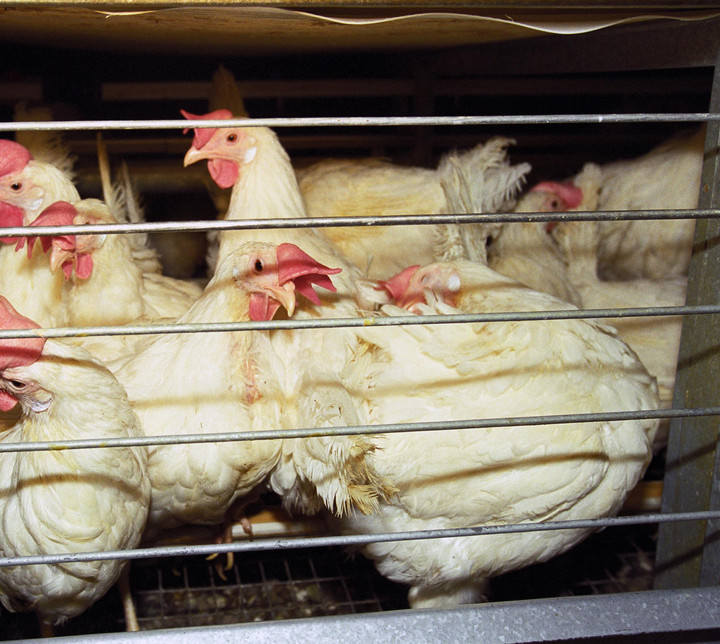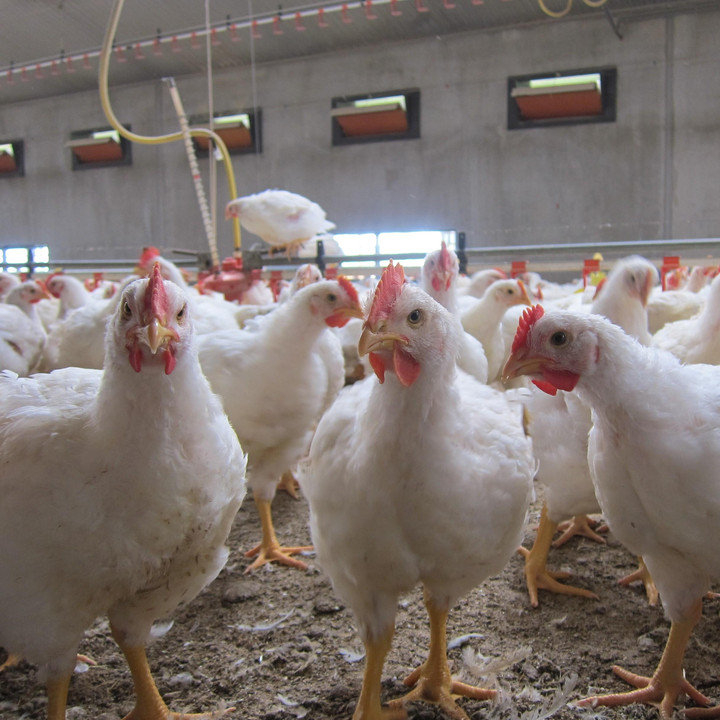
Types of Husbandry for Laying Hens
How do chickens live in a cage, a barn, in free-range or in organic farming systems?
Laying hens are kept in various ways in the egg industry. Most of them are extremely stressful for the chickens. FOUR PAWS explains how hens are living when caged, in a barn, and in free-range and organic husbandry systems.1

First digit on the EU-egg stamp: 3 stands for caged in small groups
Four to five hens live in one cage.
Wire mesh floor, without daylight with possibilities for scratching. Perches and a nest.
5-10% die prematurely in the cage.
Read more here.

First digit on the EU-egg stamp: 2 stands for barn housing
Nine hens per m². Perches and nests.
Over 6,000 hens can be crowded into one barnflock.
Crowd-induced stress is a common cause of death.
Read more here.

First digit on the EU-egg stamp: 1 stands for free range
The conditions in the barn correspond to those of barn housing.
Read more here.

First digit on the EU-egg stamp: 0 stands for organic farming
At least a third of the stable area is a littered scratching area, and laying nests and perches available.
Max. 3,000 hens in one glock
Read more here.
Cage and small group housing
Outside of the EU, the laying hens often live in tiny cages in conventional battery cells. A chicken has an area of 550 square centimetres – less than an A4 sheet of paper. Four to five hens live in a cage. These cages are in double rows and up to eight floors above each other.
The laying hens live crowded together on wire mesh floor, without daylight. They cannot scratch the ground, flutter their wings, or sandbathe. Synthetic vitamins, medicine and colourings are added to the feed and the daily animal losses are high.
A lack of exercise and sunlight cause brittle bones and osteoporosis. Serious injuries, such as broken bones and wing fractures, are common. Standing on the wire mesh will injure the ball of the toes. Since the animals cannot scratch the ground, their claws do not wear out and the chickens can easily injure each other.
In addition to the obvious illnesses and injuries, there is constant stress. The hens cannot live out their species-appropriate behaviour in the laying battery cages: They can neither peck and sandbathe, nor stretch their wings. Resting, walking, jumping, or flying is also of course not possible.
The martyrdom of the chickens in the laying battery cages lasts about 12 to 14 months. However, five to ten percent of the animals do not survive this time and die prematurely in the cage. Often undetected by the staff, they are trampled through the bars by the other hens.
These conventional cages have been banned in the EU in 2012. Now only the so-called 'enriched cages' are allowed. Each chicken has 750 square centimetres of space (so the size of a mobile phone added to A4 paper). In the cage there are 'laying nests', 'perches' and a 'scratching surface', but these do not deserve their names, as they are only a plastic mat, a thin plastic stick and maybe a sanding paper. They do not even begin to meet the needs of the animals.
Whether cages, the so-called enriched cages or small group housing – behind all these terms there are cages in which chickens cannot live in a species-appropriate manner!
Therefore, pay attention to the first digit on the egg stamp: 3 stands for cage!
Barn housing
Most of the chickens in egg production are now barn-housed. Nine hens per square metre live in huge halls if they are kept on the floor only. If perches and laying nests are installed on several floors (so-called aviary housing), it can even be 18 hens per square metre.
Even more than 6,000 hens can be crowded into such a compartment. This overwhelms the animals when it comes to the formation of hierarchies and pecking order – this, amongst other factors, leads to behavioural disorders such as feather pecking and cannibalism and to the so called 'crowding effect' – animals step back from their normal behaviour to tolerate the high crowding for preserving lifesaving resources. This instinct is functional if it lasts for a short time; however if it is constantly overused, it will lead to stress and aversive effects for health and welfare. Crowd-induced stress is a common cause of death for barn hens.2
As in cage rearing, the hens also lack employment in barn husbandry systems because there is no green space. Behaviours such as foraging, scratching, and pecking can only be practiced to a limited extent, especially since the animals have less space here than in free-range husbandry. Regularly bringing in fresh litter and similar occupational materials is particularly important here.
Look out for the egg stamp: 2 stands for barn housing.
Free range
When kept free-range, the chickens have at least 4 square metres of exploration space per animal during the day.3 The conditions in the barn correspond to those of regular barn housing. Perches, laying nests and littered scratching areas are available. With this type of husbandry, the hens' basic needs can be implemented much better than in the cage.
But problems can also arise in large free-range holdings, for example overexploitation of the exercise area near the stall and the green area. Parasites can accumulate in puddles and muddy areas and affect the health of laying hens. To prevent this, it is necessary to regularly remove and replace the floor material near the stall. There are various ways of keeping it dry and hygienically clean, for example by pouring coarsely structured, water-permeable material.
There is also a problem that the animals do not use the space to the full extent due to a poorly structured pasture run. Shelter, bushes, and pastures that are close to the stall, make it easier for the hens to go out, as they feel protected and can immediately find shelter in the event of danger (e.g. from birds of prey). A regular change of pastures is also necessary in order to maintain the grass turf. Unfortunately, these management requirements are often not taken into account and it is claimed that the animals do not want to go outside.2
Look for the egg stamp: 1 stands for free range.
Organic farming
With organic farming, each chicken has at least 4 square metres of exercise space. A maximum of six animals per square metre may be kept in the barn. At least a third of the stable area is a littered scratching area, and laying nests and perches are available. A maximum of 3,000 hens may be housed in one flock. Prophylactic use of medication is prohibited.3
Within the 4-scales of egg regulation, the best option for laying chickens is the organic farming husbandry system. This means, for example, that the animal husbandry is bound to the area: only as many animals are kept as can be fed by the area, only as much manure is produced as the soil can absorb nutrients. The feed is produced without pesticides, chemically synthetic fertilisers, and genetic engineering.
Of all the forms of husbandry, organic farming is potentially the most animal-friendly. However, the husbandry rules are not always observed in practice. In addition, the large groups can also lead to behavioural disorders in the animals. Overbreeding of laying hens is another cause of animal suffering, also in organic farms.
Pay attention to the egg stamp: 0 stands for organic farming.
Problems in keeping laying hens
Problems can arise in any form of keeping laying hens. Behavioural disorders, such as feather pecking and cannibalism, occur particularly in large facilities with many thousands of animals per group. That is why the tip of the beak of most laying hens is still clipped (trimmed) today. This procedure is performed on the chicks in the first days of life and is extremely painful. It happens regularly that the animals die as a result. In principle, no hens with trimmed beaks may be kept on organic farms and farms that meet special animal welfare requirements. There are also countries that have prohibited beak trimming altogether, but have still maintained good feather scores and low levels of pecking and cannibalism, proving that beak trimming is not the only answer to those issues.2,4
However, such problems are seldom observed in well-managed farms with smaller stocks. Ultimately, what matters is the attitude and vigilance of the operations manager. One of the most animal-friendly forms of keeping laying hens is the mobile chicken coop. But a fixed housing system with well-run exercise and pasture management can also be described as very animal-friendly.
Chick killing for all types of husbandry
From an animal welfare point of view, one of the biggest problems in the egg industry is, that every form of keeping of laying hens is preceded by what is known as 'sexing'. All male chicks are sorted out and killed. Day-old male chicks will not lay eggs and are therefore uneconomical for the industry. Learn more about day-old male chicks here.
Source
2. Lay DC, Fulton RM, Hester PY, Karcher DM, Kjaer JB, Mench JA, Mullens BA, Newberry RC, Nicol CJ, O’Sullivan NP, et al. Hen welfare in different housing systems. Poultry Science. 2011;90(1):278–294. doi:10.3382/ps.2010-00962
3. Organics at a glance. 2023 Jul 18 [accessed 2023 Aug 24]. https://agriculture.ec.europa.eu/farming/organic-farming/organics-glance_en
4. Riber AB, Hinrichsen LK. Welfare Consequences of Omitting Beak Trimming in Barn Layers. Frontiers in Veterinary Science. 2017;4:222. doi:10.3389/fvets.2017.00222

